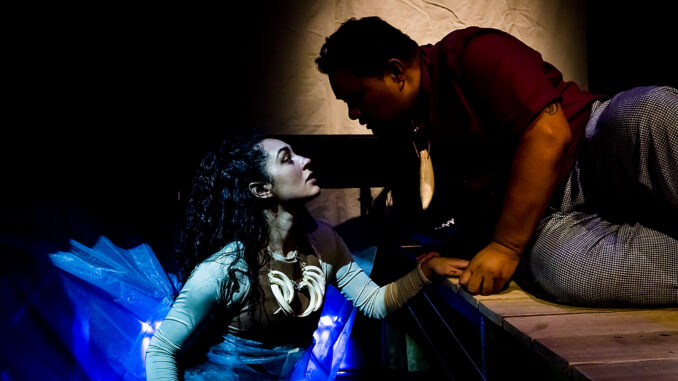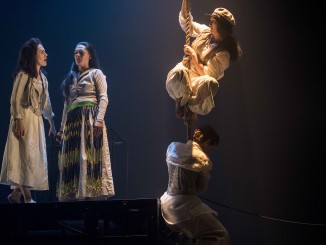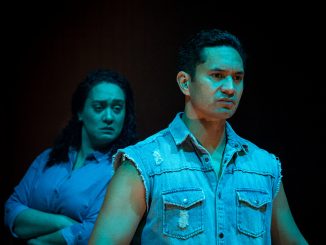
[Beyond the Pairs of Opposites]
“Our mind is capable of passing beyond the dividing line we have drawn for it. Beyond the pairs of opposites of which the world consists, other, new insights begin.”
― Hermann Hesse
Taki Rua’s Sing to Me opened at Rangatira Q Theatre as part of the Auckland Arts Festival on 11 March to limited capacity due to Covid Level 2 lockdown conditions. Written by Alex Lodge and directed by Miriama McDowell, the play brings together a myriad of seemingly opposite elements; the sky and the ocean, old Māori legends and a contemporary world facing climate crises, colloquial kiwi slang and Shakespearean-style poetry, naturalistic acting and stylised physical movement – all to explore the nature of love in binding things together. Despite the social distancing and the limited numbers, the audience at Q Theatre seemed drawn in by this production which playfully explores the collision that results when a slightly awkward optometrist Ata (Rutene Spooner) falls in love with a defiant sea maiden Whetū (Emma Katene).
The play is based on a re-telling of the Māori legend of the sea maiden Pānia from the Ahuriri (Napier) area, who would come ashore at night to visit a sweet water stream where she met and fell in love with the chief Karitoki. According to the legend, Pānia was unable to stay on land during the day and would retreat to the ocean before dawn. After the birth of their child Moremore, Karitoki was desperate to keep his family together and tried to deceive Pānia with food and a spell that would keep her on the land. But the deception was uncovered and Pānia and her son fled to the ocean and are now seen as kaitiaki (guardians) of the waters around Hawke’s Bay.
A strong thread running through the play is the dangers of climate change and the lack of care that land-dwellers extend to the ocean and the beings that inhabit the water. The set design by Jane Hakaraia sees much of the play staged in the tidal zone between land and sea. A raked stage covered in a blue material creates the impression of the tide reaching up the shore. A small wooden pier is positioned stage left and a small platform is stage right out of which curved beams protrude, reminiscent of the ribs of a whale. A clever pully system allows the material representing the water to be pulled up or downstage to recreate the impression of changing tides. A large scrim covers the backwall of the playing area where images (by Philip Merry) and video (by Michael and Lucy de Young, and Nathan MckEndry) are projected, helping to shift the location of the action from the beach to city streets and into the underwater world.
As the play begins, the Musician and narrator (Te Aihe Butler) enters to speak in direct address to the audience. Throughout the play the character not only provides poignant narration but also interacts with the other characters by playing small parts as well as providing musical accompaniment through song and guitar.
A short time later we are introduced to Ata, a slightly trepidatious optometrist who longs for adventure but seems to lapse into panic attacks whenever he tries to purchase his long-planned flight to Japan. Rutene Spooner brings a good emotional range to his performance of Ata, with the awkward comic moments in the first act giving way to darker mental anguish in the second act when relationships are stretched to breaking. We encounter Ata as he sits on the peer at the water’s edge enjoying his Chicken Katsu – and reciting lines from Elliot, confessing that he is confused by women, and that he has been planning a trip to Japan. The quotidian quality in Ata’s delivery is contrasted sharply a moment later when the audience are introduced to Whetū who glides along the ground beneath the raked sections of stage that make up the beach and slowly emerges from the waves by poking her head up through the blue fabric stretched across the forestage. Emma Katene brings a strong physical characterisation to the role that transforms from the fluid movements of the water world to the clunky and heavy physicality weighted down by worry and pregnancy later in the play. In contrast to Ata, Whetū uses a poetic language reminiscent of Shakespeare while brandishing a dagger to threaten a shocked Ata into awe. At first the combination of these opposing forms of dialogue is a bit awkward and jarring, but audiences are soon delighting in Alex Lodge’s wonderful writing and humour as the play progresses and finds its rhythm.
As a story about parents from different cultures attempting to navigate cross-cultural currents, the play holds special significance for the writer, director and cast. As Miriama McDowell points out in her Director’s Note, all but one of the cast and crew for the show are children of Māori and Pākehā parentage. One of the more poignant aspects of the play is the way writer Alex Lodge, a Pākehā mother with a Māori son, has captured the ebb and flow of a relationship dealing with the aspirations and fears of new parents. In one scene a pregnant Whetū complains about her achingly heavy body and wonders whether walking on land will ever get easier. In another, Ata’s nerves fray from the lack of sleep which he manages by going for nighttime walks and taking up smoking. There is a truthfulness in the writing and presentation of these moments that transcend cultural differences and allows audiences to acknowledge the universal trials and tribulations of parenting. Set against a backdrop of a climate crisis, these moments take on an even more greater significance.
An outstanding feature of the production is the musical numbers that sustain the action. Shortly after the two main characters Ata and Whetū are introduced, the cast sit onstage to give a heart-warming rendition of Paolo Nutini’s ‘Someone Like You’. Here the musical talents of the cast are revealed as they sing in harmony, with Ata dancing and Butler providing accompaniment on guitar. This cast can act, they all have good comic-timing, but they can also sing, and importantly they all bring a sense of play and joy to their performances. I suspect that the pleasure that the cast exuded onstage can be attributed to McDowell’s direction. This sense of play might be attributed to McDowell’s background with Massive Company and the influence of Philippe Gaulier and French clowning for which ‘le jeu’ or ‘the play’ is a foundational pedagogy and philosophy. Despite the urgency of the climate emergency that the play draws attention to, or the darker currents of betrayal circulating beneath this love story, there is a strong element of playfulness that binds the various elements of the production together.
The binding of opposing elements leads to a particularly moving scene in which Ata and Whetū dance to a guitar played by Butler on the side of the stage. In the lead up to the scene Te Aihe Butler uses a microphone to recreate the voice of nature documentary-maker Sir David Attenborough as he describes the song and underwater dance of the humpback whale. When the microphone is replaced by guitar, the humour gives way to a beautiful moment in which the dancing lovers Ata and Whetū glide across the stage while remarkable underwater video footage of two whales drifting gracefully together is projected onto the backdrop. The scene manages to bring several seemingly opposite elements together to reveal an exquisite moment of theatre that fosters insight into the nature of love, connection and environment.
Sing to Me is presented by Taki Rua and played at Q Theatre 11-13 March 2021 as part of the Auckland Arts Festival. It tours to Palmerston North, Christchurch and Dunedin.




Leave a Reply